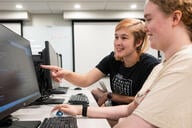You have /5 articles left.
Sign up for a free account or log in.

istockphoto.com/jacoblund
WASHINGTON -- Educators employ high-impact practices in the classroom with the goal of keeping students engaged in the course material and developing skills they can apply in other courses and beyond. During a panel last Friday at the Association of American Colleges and Universities conference, three instructors offered insights into practices they’ve adopted in their online classrooms that elevate the course experience beyond conventional recorded lectures and quizzes.
Steven Greenlaw, a professor of economics at the University of Mary Washington, in Virginia, recently participated in an institutionwide study aimed at the challenges of offering high-quality instruction in online and hybrid formats. A key finding of the study, according to Greenlaw, came when looking at the potential for high-impact practices to make a meaningful difference. The term “high-impact practices” encompasses classroom activities designed to promote learning, engagement and completion. Examples of high-impact practices are in bold throughout the story; others include learning communities, practicums, supervised fieldwork and first-year seminars.
“High-impact practices work pretty much just as well in an online environment as they do face-to-face,” Greenlaw said. “You just sometimes have to do things a little bit differently.”
Gretchen McKay, a professor of art history at McDaniel College, in Maryland, keeps her students writing throughout her course in Byzantine art, part of the Council of Independent Colleges' effort to offer more options to students at multiple institutions through online courses. In addition to participating on discussion boards, McKay asks students to maintain a regular learning log, upon which they reflect at various points throughout the semester -- replacing class discussions that would take place face-to-face. Active reflection in this writing-intensive environment helps them deeply process and more easily recall the material, even at a distance.
Greenlaw incorporated writing-intensive elements into his introductory economics course, which is populated mainly by residential students who opted for the online option. His instructions for writing papers were identical to those for face-to-face students, but he gave online students the option to turn in early drafts for feedback before they submit the final version.
One of the key projects in McKay’s course is a collaborative writing assignment -- using image searching to document classical visual references in The Paris Psalter, a Byzantine illustrated manuscript from the year 1133. Though the logistics of partnerships between students who don’t have physical access to each other might seem daunting, McKay said she lets the partnerships form organically, and her students have generally managed to equally distribute the workload through email communication.
The finished products end up occupying an online digital humanities project that collects student work around Italo-Byzantine art, helping McKay hit two more high-impact practices: student content creation and student-faculty collaboration.
Collaboration within assigned three-person study groups was similarly fruitful in Greenlaw’s course, though he was never able to avoid the reality that “certain students didn’t want to play the game.” He also held a synchronous weekly Google Hangout, during which he fielded questions and offered some lecture. The videos were immediately archived after recording wrapped up, and most students returned to them at least once, Greenlaw said.
At St. Edward’s University in Texas, Rebecca Frost Davis, director of instructional and emerging technology, collaborated with her institution's academic affairs department, instructional designers and other faculty members to create an online version of her capstone course when she heard that many students had already fulfilled their other requirements and left the university -- to apply for medical school or otherwise prepare for their postgraduate careers -- but still needed to complete this last course.
The learning objective is for students to think critically and apply moral reasoning to complex problems, and to make reasoned decisions about issues in accordance with their values. Davis asked students to choose a policy issue, write about it from multiple perspectives and ultimately determine their own position.
To prevent the exercise from becoming overly insular and academic, Davis incorporated a community-based learning element: requiring students to complete interviews on both sides of the issue with experts. Motivating students to complete this task was a challenge, Davis said, until she scaffolded the assignment by requiring proposals for interview subjects early on.
Expanding Definitions
Friday’s panel ended with an opportunity for audience members to weigh in with ideas for incorporating high-impact practices in their own classrooms. A photography professor, for instance, said she incorporates peer review by requiring online students to draw each other’s photographs using only a written description.
Jesse Stommel, executive director of the division of teaching and learning technologies at Mary Washington, said during that portion that he wants to see informal, self-motivated discussions considered as a high-impact practice of sorts. In his face-to-face classes, he sometimes starts class by asking how students spent their weekends, and students sometimes approach him after class for free-flowing conversations that last 10 minutes or more.
He thinks creating an environment where similar spontaneity can flourish would make a high impact as well.
We welcome ideas from you for incorporating high-impact practices into your own classrooms. Please share in the comments section below.




